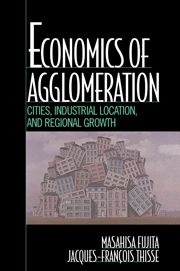Book contents
- Frontmatter
- Contents
- Acknowledgments
- 1 Agglomeration and Economic Theory
- PART I FUNDAMENTALS OF GEOGRAPHICAL ECONOMICS
- PART II THE STRUCTURE OF METROPOLITAN AREAS
- PART III FACTOR MOBILITY AND INDUSTRIAL LOCATION
- 8 Industrial Agglomeration under Marshallian Externalities
- 9 Industrial Agglomeration under Monopolistic Competition
- PART IV URBAN SYSTEMS AND REGIONAL GROWTH
- References
- Name Index
- Subject Index
8 - Industrial Agglomeration under Marshallian Externalities
Published online by Cambridge University Press: 05 June 2012
- Frontmatter
- Contents
- Acknowledgments
- 1 Agglomeration and Economic Theory
- PART I FUNDAMENTALS OF GEOGRAPHICAL ECONOMICS
- PART II THE STRUCTURE OF METROPOLITAN AREAS
- PART III FACTOR MOBILITY AND INDUSTRIAL LOCATION
- 8 Industrial Agglomeration under Marshallian Externalities
- 9 Industrial Agglomeration under Monopolistic Competition
- PART IV URBAN SYSTEMS AND REGIONAL GROWTH
- References
- Name Index
- Subject Index
Summary
INTRODUCTION
The work of Marshall has been very influential in regional and urban studies and has led to the concept of Marshallian externalities, which aim at accounting for the benefits associated with cluster formation. As seen in Chapter 1, these benefits arise because of
the formation of a highly specialized labor force and the development of new ideas, both based on the accumulation of human capital and face-to-face communications (the latter has been analyzed in Chapter 6);
the availability of specialized input services (see Chapter 4); and
the existence of modern infrastructure (see Chapter 5).
From the point of view of this chapter, the main distinctive feature of these externalities is that they affect only the agents belonging to the same geographical area. They do not spread over other regions or, more precisely, their impact on distant regions may be considered negligible.
The now standard classification of Marshallian externalities is attributed to Hoover (1936, chap. 6): (1) the localization economies, which are defined as the benefits generated by the proximity of firms producing similar goods; and (2) the urbanization economies, which are defined by all the advantages associated with the overall level of activity prevailing in a particular area. These external effects have been studied extensively from the empirical standpoint (see, e.g., Henderson 1988, chap. 5, and the references therein). For example, Hanson (1996, 1266) accurately points out that “the fact that New York City remains a major apparel producer is perhaps the most persuasive evidence one can find of localization economies.”
- Type
- Chapter
- Information
- Economics of AgglomerationCities, Industrial Location, and Regional Growth, pp. 267 - 302Publisher: Cambridge University PressPrint publication year: 2002



